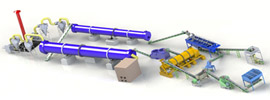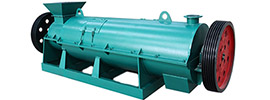The following is the translation of the text into English while maintaining the original context:
Why Does Organic Fertilizer Require Aerobic Fermentation?
Organic fertilizer necessitates aerobic fermentation primarily due to the following scientific principles and practical advantages:
I. Core Principle: Microorganism-Driven Efficient Conversion
Aerobic fermentation refers to the process where aerobic microorganisms (such as bacteria and actinomycetes) decompose organic matter into stable humus under oxygen-rich conditions. The key mechanisms include:
- High-Temperature Sterilization of Pathogens: During fermentation, the pile temperature can reach 55-70°C, effectively killing pathogens, parasite eggs, and weed seeds, thereby achieving harmlessness.
- Mineralization and Humification of Organic Matter:
- Mineralization: Microorganisms break down large organic molecules (such as proteins and cellulose) into small nutrient molecules (such as nitrogen, phosphorus, and potassium) that can be directly absorbed by plants.
- Humification: Synthesis of new high-molecular compounds—humus, which is the core component of soil fertility, improving soil structure, water retention, and fertilizer retention.
- Oxygen-Driven Metabolism: Aerobic microorganisms proliferate rapidly through aerobic respiration, with significantly higher metabolic efficiency than under anaerobic conditions, accelerating the fermentation process.
II. Advantages of Aerobic Fermentation Compared to Anaerobic Fermentation
| Comparison Dimension |
Aerobic Fermentation |
Anaerobic Fermentation |
| Product Quality |
Produces humus, high fertilizer efficiency, no odor |
Generates methane and organic acids, prone to odor, low fertilizer efficiency |
| Processing Efficiency |
Short cycle (15-20 days), suitable for industrialization |
Long cycle (several months), low efficiency |
| Environmental Impact |
Thorough harmlessness, environmentally friendly |
Requires treatment of biogas and leachate, prone to pollution |
| Cost and Application |
Simple equipment, low cost, easy promotion |
High investment, requires supporting biogas projects |
III. Key Practical Advantages of Aerobic Fermentation
- Sterilization and Weed Control, Ensuring Safety:
- The high-temperature phase (above 55°C) lasting for 5-7 days can eliminate over 99% of pathogenic microorganisms and weed seeds, ensuring fertilizer safety.
- Enhancing Fertilizer Efficiency and Soil Improvement:
- Generates a large amount of available nitrogen, phosphorus, and potassium for direct plant absorption.
- Synthesizes humus, increasing soil organic matter content and improving soil aggregate structure.
- Environmentally Friendly and Odorless, Reducing Pollution:
- Avoids the production of foul-smelling gases like hydrogen sulfide and ammonia under anaerobic conditions. Technologies such as membrane covering (e.g., microporous functional membranes) can further isolate pathogenic microorganisms and aerosols.
- Strong Adaptability and Resource Utilization:
- Can process various organic wastes such as livestock manure, straw, and sludge, realizing "waste-to-resource" conversion and aligning with the concept of a circular economy.
IV. Process Essentials and Scientific Basis
- Oxygen Supply Control: Combine forced aeration with pile turning to ensure uniform oxygen distribution and avoid local anaerobic conditions.
- Temperature Management: Avoid excessively high pile temperatures (>70°C) to prevent microbial activity inhibition.
- Carbon-Nitrogen Ratio (C/N): Optimal C/N ratio is 25-35:1. Add nitrogen sources (e.g., urea) if too high, or carbon sources (e.g., straw) if too low.
- Moisture Adjustment: Maintain moisture content at 55-65%. Increase aeration or spray water if too high or low, respectively.
V. Summary
Aerobic fermentation transforms organic waste into safe, high-quality organic fertilizer through a high-temperature, efficient, and harmless microbial metabolic process, while also achieving resource recycling and environmental protection. Its scientific principles and practical advantages make it the mainstream technology for organic fertilizer production.
 Send us a Email
Send us a Email Wulong Industrial Cluster
Wulong Industrial Cluster Have any question?
Have any question?



















